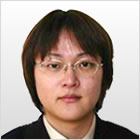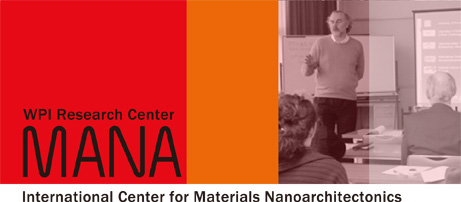Genki Yoshikawa

- Affiliation:
-
- MANA, NIMS
- Specialty:
- Piezoresistive Cantilever Array Bio-sensors, Nanomechanical sensors, Surface Science
- Academic degree:
- Ph.D. in Science, The University of Tokyo (2004)
- Recent publications
- See Personal Page
Education History
| 2011 Aug | - | Present | MANA Independent Scientist, MANA, NIMS. |
| 2009 | - | 2011 Jul | ICYS-MANA Researcher, MANA, NIMS. (Prof. Masakazu Aono). |
| 2008 | - | 2009 | MANA Research Associate, MANA, NIMS. (Prof. Masakazu Aono). |
| 2007 | - | 2009 | Visiting Scientist, Department of Physics, University of Basel. (Prof. Christoph Gerber). |
| 2005 | - | 2008 | Assistant Professor, Institute for Materials Research (IMR), Tohoku University, Japan. (Prof. Toshio Sakurai). |
| 2004 | - | 2005 | Postdoc Fellow (COE Researcher), Chemistry, University of Tokyo. (Prof. Koichiro Saiki). |
| 2001 | - | 2004 | Ph.D. candidate, Department of Chemistry, The University of Tokyo. (Prof. Koichiro Saiki). |
| 1999 | - | 2001 | M.S. Student, Department of Chemistry, The University of Tokyo. (Prof. Atsushi Koma). |
| 1995 | - | 1999 | B.S. Student, Department of Chemistry, The University of Tokyo. (Prof. Atsushi Koma). |
Research Interest
Cantilever array sensors
Microfabricated cantilever arrays are emerging as label-free and real-time sensors for detecting tiny amount of various target molecules in parallel. Adsorption of analytes on a receptor layer coated on a cantilever surface induces surface stress, which makes the cantilever bend (static mode). This simple mechanics opened a myriad of possibilities for the use of cantilever deflection technique developed for atomic force microscopy beyond imaging to sensing. Cantilever array sensors can be also utilized as a simple microbalance with extremely high sensitivity, oscillating at a resonance frequency (dynamic mode). Applications ranging from chemistry to genomics have been demonstrated, for example, detection of volatile organic compounds, triggered marker genes, antigens, viruses, fungi, etc. In addition to these sensing applications, the very unique feature of detecting surface stress in the static mode adds further potential to reveal various biological phenomena accompanied by structural changes, exploring the new field: "Nano-mechanical analysis." Thereby, dual mode operation utilizing both static and dynamic mode will realize the real-time comprehensive monitoring of analytes adsorption (mass change) followed by structural changes (stress change).
New piezoresistive cantilever array sensors
In contrast to conventional optical (laser) read-out technique for the measurement of cantilever deflection, piezoresistive read-out system does not require bulky and expensive instrumentation. This approach contains various advantages, such as low cost, simple operation, and miniaturization of the whole system into a match-box sized device. In addition, piezoresistive read-out can be operated even in opaque liquids, such as blood, which are almost impossible to handle with an optical system. Further optimization of piezoresistive cantilevers and integration of various technologies (microfluidics, etc) will open the door to a new era of medical diagnostic as well as genetic and environmental researches in the near future.
Selected Papers
- Nanomechanical Membrane-type Surface Stress Sensor
- Yoshikawa G, Akiyama T, Gautsch S, Vettiger P, and Rohrer H
- Nano Lett, 2011; 11(3): 1044-1048.
- Mechanical analysis and optimization of a microcantilever sensor coated with a solid receptor film
- Yoshikawa G
- Appl Phys Lett, 2011; 98(17), 173502.
- Noble metal-intercalated fullerene fabricated by low temperature Co-deposition
- Yoshikawa G, Tsuruma Y, Ikeda S, Saiki K
- Adv Mater, 2010; 22(1): 43-46.
- Sub-ppm detection of vapors using piezoresistive microcantilever array sensors
- Yoshikawa G, Lang HP, Akiyama T, Aeschimann L, Staufer U, Vettiger P, Aono M, Sakurai T, Gerber C
- Nanotechnology, 2009; 20(1): 015501.
- Real-time observation and control of pentacene film growth on the in-plane heterogeneous substrate
- Tsuruma Y, Al-Mahboob A, Ikeda S, Sadowski JT, Yoshikawa G, Fujikawa Y, Sakurai T, Saiki K
- Adv Mater, 2009; 21(48): 4996-5000.
- Spontaneous aggregation of pentacene molecules and its influence on field effect mobility
- Yoshikawa G, Sadowski JT, Al-Mahboob A, Fujikawa Y, Sakurai T, Tsuruma Y, Ikeda S, Saiki K
- Appl Phys Lett, 2007; 90(25): 251906.
- In situ measurement of molecular orientation of the pentacene ultrathin films grown on SiO2 substrates
- Yoshikawa G, Miyadera T, Onoki R, Ueno K, Nakai I, Entani S, Ikeda S, Guo D, KiguchiM, Kondoh H, Ohta T, Saiki K,
- Surf Sci, 2006; 600(12): 2518-2522.


